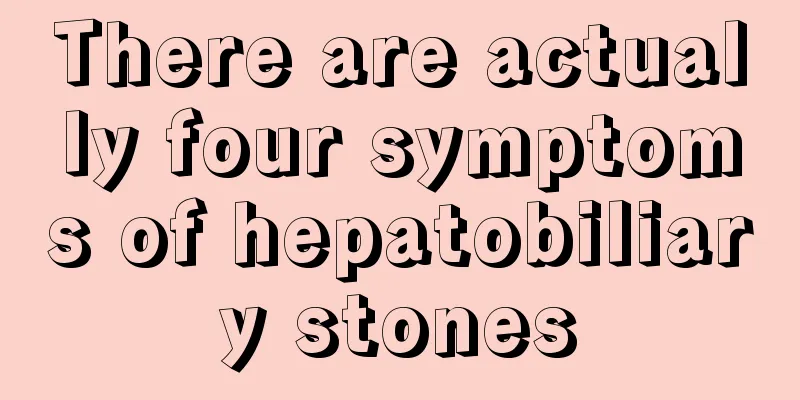There are actually four symptoms of hepatobiliary stones

|
Hepatobiliary stones are one of the diseases with a relatively high incidence in daily life, especially in Fujian, Jiangxi and other places where the incidence rate can reach as high as 30-40%, seriously affecting human health. So what are the symptoms of hepatobiliary stones? Most people don't really understand this. In fact, hepatobiliary stones are also called intrahepatic bile duct stones, which have the following four symptoms. Symptoms of intrahepatic bile duct stones What are the symptoms of intrahepatic bile duct stones? For those who don’t understand intrahepatic bile duct stones, they definitely don’t know the symptoms of intrahepatic bile duct stones. But it doesn’t matter. The following editor will introduce to you the symptoms of intrahepatic bile duct stones. 1. Upper abdominal pain may be typical biliary colic or persistent bloating. Some patients do not experience obvious pain, but have very obvious chills and fever, which occur periodically. 2. There may be a long history of biliary disease, or a history of acute cholangitis accompanied by chills, fever, and jaundice. 3. Patients with intrahepatic bile duct stones will experience pain in the liver and lower chest, which will radiate to the back and shoulder areas. 4. In the acute phase, symptoms of acute suppurative cholangitis or varying degrees of Charcot's triad (pain, chills, fever, and jaundice) may appear, most of which may be caused by concurrent extrahepatic bile duct stones. 5. There is obvious tenderness and percussion pain in the liver area, and the liver is asymmetrically enlarged and tender. Characteristics of intrahepatic bile duct stones 1. The age of onset is generally 30-50 years old, but nowadays many people in their 20s are likely to suffer from this disease. 2. Upper abdominal pain is a symptom experienced by many patients with intrahepatic bile duct stones. It often manifests as colic or persistent bloating, and is also accompanied by chills. 3. There may be a long history of biliary disease, or a history of acute cholangitis accompanied by chills, fever, and jaundice. 4. There is frequent pain and discomfort in the affected liver area and lower chest, which often radiates to the back and shoulders. 5. When one side of the hepatic duct is obstructed, there may be no jaundice or the jaundice may be very mild. 6. When combined with severe cholangitis, the general condition is more serious and recovery is slower after an acute attack. 7. During the examination, there is obvious tenderness and percussion pain in the liver area, and the liver is asymmetrically enlarged and tender. 8. The general condition is significantly affected, 90% of patients have hypoproteinemia and 1/3 of patients have obvious anemia. 9. In the late stage, there are symptoms of liver and spleen enlargement and portal hypertension. |
<<: There are 3 ways to remove dental tartar
>>: The symptoms of tuberculous pericarditis are like this
Recommend
Is colorectal cancer really hereditary?
Oncologists say that the occurrence of colorectal...
What does liver puncture biopsy mean
Liver puncture biopsy mainly involves biopsy of l...
Will condoms leak?
Condoms can also cause leakage and are not 100% s...
Where can I remove moisture by fumigating with moxa sticks
Moxibustion is a health-preserving method in trad...
What causes dry and stinging skin
When dry skin and stinging occur, it is important...
Don't be stubborn and miss the best time for treatment
Lao Hu, who was in good health on weekdays, has n...
Five treatment principles for recurrent cervical cancer
Cervical cancer is a malignant tumor with a high ...
How to treat hamartoma so that it heals quickly
No matter what disease occurs, people’s first tho...
Is there a mole where I wear a watch?
Many people usually have the habit of wearing wat...
Benefits of taking a walk after a meal
Exercise is very beneficial to us. In fact, walki...
What treatments are effective for hemorrhoids and anal fissures?
Hemorrhoids and anal fissures are also relatively...
Which one should be supplemented first when both kidney yin and yang are deficient
People may often wonder which one should be suppl...
Basic yoga moves are simple and easy to learn
Yoga is gradually becoming popular in our lives. ...
What is the difference between dark circles and eye bags?
Everyone must be familiar with dark circles. Dark...
Be more careful to prevent heat stroke in the beginning of autumn
Should we be more careful about preventing heatst...









